
Poznań
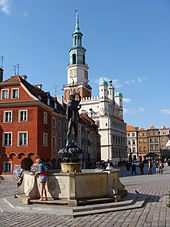 Poznań (Latin: Posnania; German: Posen) is a city on the Warta river in west-central Poland, the region called Greater Poland. The population stood at 551,627 in 2010, while the continuous conurbation including Poznan County is inhabited by 1 million people. The city forms the largest metropolitan area in western Poland and fourth largest in the country (almost 1.5 million inhabitants).
Poznań (Latin: Posnania; German: Posen) is a city on the Warta river in west-central Poland, the region called Greater Poland. The population stood at 551,627 in 2010, while the continuous conurbation including Poznan County is inhabited by 1 million people. The city forms the largest metropolitan area in western Poland and fourth largest in the country (almost 1.5 million inhabitants).
Poznań is among the oldest cities in Poland and was one of the most important centres in the early Polish state in the tenth and eleventh centuries. The Kingdom of Poland began in Poznan, namely on the natural island on the Warta river very similar to the Île de la Cité in Paris. The first rulers were buried at Poznań's cathedral on the island. It was the first Capital City of the Kingdom of Poland and also served as the capital in the 13th century, hence the official name: The capital city of Poznan.
Poznań is now Poland's fifth largest city. It is the historical capital of the Wielkopolska ("Greater Poland") region and is currently the administrative capital of the province called Greater Poland Voivodeship. Poznań is today one of the largest Polish centers of trade, industry, sports, education, technology, tourism and culture.
The city hosts regular international trade fairs and was the host city for the United Nations Climate Change Conference in December 2008, a key stage in the creation of a successor to the Kyoto Protocol. Poznań was one of the host cities for the association football tournament UEFA Euro 2012. The city also hosts a number of rowing world cup events by the Malta lake (for example "ICF Canoe Sprint World Championships" in 1990, 2001, and again in 2010). Also, a great number of various international festivals takes place in the city - Transatlantyk – Poznań International Film and Music Festival, "Malta International Theater Festival" and "Maski Festival" to name just a few. What more the International Henryk Wieniawski Violin Competition, the oldest violin competition in the world, is held in Poznań every five years.
In 2012 the Poznań's Art and Business Center "Stary Browar" won a competition organized by National Geographic Traveller and was given the first prize as one of the seven "New Polish Wonders". Poznań has been rated highly, often coming first for Poland, as a city with a very high quality of life. The city has also won many times a prize awarded by "Superbrands" for a very high quality brand of city of Poznań. Poznań was classified in 2010 as high sufficiency city by Globalization and World Cities Research Network.
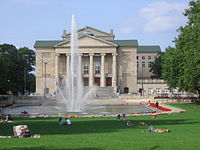
Names
The name Poznań probably comes from a personal name, Poznan, (from the Polish participle poznan(y) – "one who is known/recognized"), and would mean "Poznan's town". It is also possible that the name comes directly from the verb poznać, which means "to get to know" or "to recognize". It may simply mean "known town".
The earliest surviving references to the city are found in the chronicles of Thietmar of Merseburg, written between 1012 and 1018: episcopus Posnaniensis ("bishop of Poznań", in an entry for 970) and ab urbe Posnani ("from the city of Poznań", for 1005). The city's name appears in documents in the Latin nominative case as Posnania in 1236 and Poznania in 1247. The phrase in Poznan appears in 1146 and 1244.
The city's full official name is Stołeczne Miasto Poznań ("The Capital City of Poznań"), in reference to its role as a centre of political power in the early Polish state. Poznań is known as Posen in German, and was officially called Haupt- und Residenzstadt Posen ("Capital and Residence City of Poznań") between 20 August 1910 and 28 November 1918. The Latin names of the city are Posnania and Civitas Posnaniensis. Its Yiddish name is פּױזן, or Poyzn.
The Russian version of the name, Познань (Poznan), is of feminine gender, in contrast to the Polish name, which is masculine.
History
For centuries before the Christianization of Poland, Poznań (consisting of a fortified stronghold between the Warta and Cybina rivers, on what is now Ostrów Tumski) was an important cultural and political centre of the Polan tribe. Mieszko I, the first historically recorded ruler of the Polans, and of the early Polish state which they dominated, built one of his main stable headquarters in Poznań. Mieszko's baptism of 966, seen as a defining moment in the establishment of the Polish state, may have taken place in Poznań.
Following the baptism, construction began of Poznań's cathedral, the first in Poland. Poznań was probably the main seat of the first missionary bishop sent to Poland, Bishop Jordan. The Congress of Gniezno in 1000 led to the country's first permanent archbishopric being established in Gniezno (which is generally regarded as Poland's capital in that period), although Poznań continued to have independent bishops of its own. Poznań's cathedral was the place of burial of the early Piast monarchs (Mieszko I, Boleslaus I, Mieszko II, Casimir I), and later of Przemysł I and King Przemysł II.
The pagan reaction that followed Mieszko II's death (probably in Poznań) in 1034 left the region weak, and in 1038 Bretislaus I of Bohemia sacked and destroyed both Poznań and Gniezno. Poland was reunited under Casimir I the Restorer in 1039, but the capital was moved to Kraków, which had been relatively unaffected by the troubles.
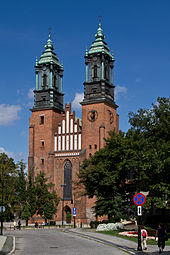
Later in the Polish–Lithuanian Commonwealth, Poznań was the seat of a voivodeship. The city's importance began to grow in the Jagiellonian period, due to its position on trading routes from Lithuania and Ruthenia to western Europe. It would become a major centre for the fur trade by the late 16th century.
In the second half of the 17th century and most of the 18th, Poznań was severely affected by a series of wars (and attendant military occupations, lootings and destruction) – the Second and Third Northern Wars, the War of the Polish Succession, the Seven Years' War and the Bar Confederation rebellion. It was also hit by frequent outbreaks of plague, and by floods, particularly that of 1736, which destroyed most of the suburban buildings. In 1793, in the Second Partition of Poland, Poznań, came under the control of the Kingdom of Prussia, becoming part of (and initially the seat of) the province of South Prussia.
In the Greater Poland Uprising of 1806, Polish soldiers and civilian volunteers assisted the efforts of Napoleon by driving out Prussian forces from the region. The city became a part of the Duchy of Warsaw in 1807, and was the seat of Poznań Department - a unit of administrative division and local government. However in 1815, following the Congress of Vienna, the region was returned to Prussia, and Poznań became the capital of the semi-autonomous Grand Duchy of Posen.
The city continued to expand, and various projects were funded by Polish philanthropists, such as the Raczyński Library and the Bazar hotel. The city's first railway, running to Stargard in Pommern (now Stargard Szczeciński), opened in 1848. Due to its strategic location, the Prussian authorities intended to make Poznań into a fortress city, building a ring of defensive fortifications around it. Work began on the citadel (Fort Winiary) in 1828, and in subsequent years the entire set of defences (Festung Posen) was completed.
A Greater Poland Uprising during the Revolutions of 1848 was ultimately unsuccessful, and the Grand Duchy lost its remaining autonomy, Poznań becoming simply the capital of the Prussian Province of Posen. It would become part of the German Empire with the unification of German states in 1871. Polish patriots continued to form societies (such as the Central Economic Society for the Grand Duchy of Poznań), and a Polish theatre (Teatr Polski, still functioning) opened in 1875; however the authorities made efforts to Germanize the region, particularly through the Prussian Settlement Commission (founded 1886).
After World War I the Greater Poland Uprising (1918–1919) brought Poznań and most of the region under Polish control, confirmed by the Treaty of Versailles. The local populace had to acquire Polish citizenship or leave the country.
During the German occupation of 1939–1945, Poznań was incorporated into the Third Reich as the capital of Reichsgau Wartheland. Many Polish inhabitants were executed, arrested, expelled to the General Government or used as forced labour; at the same time many Germans and Volksdeutsche were settled in the city. . The Nazi authorities significantly expanded Poznań's boundaries to include most of the present-day area of the city; these boundaries were retained after the war. Poznań fell to the Red Army, assisted by Polish volunteers, on 23 February 1945 following the Battle of Poznań, in which the German army conducted a last-ditch defence in line with Hitler's designation of the city as a Festung. The Citadel was the last point to fall, and the fighting left much of the city, particularly the Old Town, in ruins. The post-war years had seen much reconstruction work on buildings damaged in the fighting. From the 1960s onwards intensive housing development took place, consisting mainly of pre-fabricated concrete blocks of flats, especially in Rataje and Winogrady, and later (following its incorporation into the city in 1974) Piątkowo. Another infrastructural change (completed in 1968) was the rerouting of the river Warta to follow two straight branches either side of Ostrów Tumski.
The most recent expansion of the city's boundaries took place in 1987, with the addition of new areas mainly to the north, including Morasko, Radojewo and Kiekrz. The first free local elections following the fall of communism took place in 1990. With the Polish local government reforms of 1999, Poznań again became the capital of a larger province (Greater Poland Voivodeship). It also became the seat of a powiat ("Poznań County"), with the city itself gaining separate powiat status.
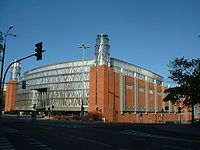
Interesting spots
Poznań has many historic buildings and sights, mostly concentrated around the Old Town and other parts of the city centre. Many of these lie on the Royal-Imperial Route in Poznań – a tourist walk leading through the most important parts of the city showing its history, culture and identity.
Results of new extensive archaeological research performed on Poznan's Ostrow Tumski by prof. zw dr hab. Hanna Kocka-Krec z Instytutu Prahistorii UAM indicate that Poznań indeed was a central site of the early Polish State (recent discovery of first Polish ruler, Mieszko I's Palatium). Thus, the Ostrow Tumski Island is more important that it was thought previously and may have been as important as "Gniezno" in the Poland of first "Piasts". In the near future "Ostrow Tumski of Poznan" is supposed to have a very rich historical exposition, which is being under construction these days and will be a very interesting place for visitors of Poznan. This will include all sorts of attractions: above mentioned Cathedral, Church of St. Mary the Virgin in Poznan, "Lubranski Academy" and newly opened in 2012 "Genius Loci Archeological Park" and Interactive Center of Ostrow Tumski History ("ICHOT") planned to be opened in 2013 presenting Polish State through many different periods in a form of multimedia museum. "Palatium in Poznan" will be also transformed into a museum, although more funds are needed. When all the expositions are ready in a couple of years Ostrow Tumski may be as worth visiting as "Wawel" in Cracow. There is a very famous sentence illustrating the importance of Ostrow Tumski in Poznań by the "Pope Jean Paul II": "Poland began here".
One of the most interesting places in Poznań is Malta with an artificial lake in its center. On one bank of the lake there are ski and sleigh slopes (Malta Ski), on the opposite bank a huge complex of swimming pools including an olympic-size one (Termy Maltanskie). This whole recreational city "district" is a unique attraction in a whole of Poland or even Europe.
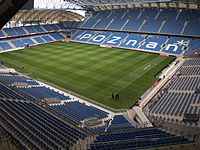 Perhaps the most important cultural event in Poznań is the annual Malta theatre festival, which takes place at many city venues usually in late June and early July. It hosts mainly modern experimental off-theatre performances, often taking place on squares and other public spaces. It also includes cinema, visual, music and dancing events. Malta Theatre Festival gave birth to many off-theater groups, expressing new ideas in an already rich theatrical background of the city. Thus, Poznań with a great deal of off-theaters and their performances has recently become a new Polish off-theater performance center.
Perhaps the most important cultural event in Poznań is the annual Malta theatre festival, which takes place at many city venues usually in late June and early July. It hosts mainly modern experimental off-theatre performances, often taking place on squares and other public spaces. It also includes cinema, visual, music and dancing events. Malta Theatre Festival gave birth to many off-theater groups, expressing new ideas in an already rich theatrical background of the city. Thus, Poznań with a great deal of off-theaters and their performances has recently become a new Polish off-theater performance center.
Classical music events include the Henryk Wieniawski Violin Competition (held every 5 years), and classical music concerts by the city's Philharmonic Orchestra held each month in the University Aula. Especially popular are concerts by the Poznań Nightingales.
WWW: poznan.pl
Wielkopolska Region
Wielkopolska – a cultural benefactor.
Wielkopolska, as the cradle of Christianity in Poland, is proud of its heritage and cultivates it. On the other hand – it is a modern region, as we know how to use these magnificent traditions in order to build the future of the next generations by investing in culture. Our region is unique compared to the rest of the country in terms of financial expenses on culture – almost 10 percent of the Region\'s budget is dedicated to this very purpose.
A significant part of these funds is provided to local cultural institutions. Museums, theatres, philharmonic, culture centres, library and film institution create a varied cultural offer, reaching to extensive circles of recipients not only in the region, but in the country and abroad. We can easily say that they are fantastic culture ambassadors of Wielkopolska and Poland in the United Europe and in the world.
We create Grand Culture also through working with non-governmental organizations, which are very active in the region. Thanks to this cooperation, such events as the International Theatre Malta Festival or the oldest violin competition in Europe - International Henryk Wieniawski Violin Competition and a little younger one, named after George Philipp Telemann. In the palace that belongs to the Radziwiłł Prince Family in Antonin, one of the five in Europe – and second in Poland next to Duszniki – Chopin Festival – entitled "Chopin in Shades of Autumn". Smaller and bigger towns of Wielkopolska host the Polish Guitar Academy in the summer.
Music is popular in Wielkopolska thanks to unique phenomena of the former music. Suffice it to mention the Baroque orchestra Arte dei Suonatori or the Musica Sacromontana – Oratory Music Festival in the Sanctuary in Święta Góra near Gostyń. Wielkopolska is also famous for its choirs. Their sheer number stems from over a hundred years of tradition of singers\' societies. These traditions are cultivated i.a. by the professional Choir of the Grand Theatre in Poznań and "Poznań Nightingales" of the Poznań Philharmonic.
The Classical music harmonizes very well with other genres. For almost 40 years Kalisz has been visited by the most renowned and skilled jazzmen and jazzwomen for the International Jazz Piano Festival. Poznań and Ostrów Wielkopolski remember their connections with Krzysztof Komeda Trzciński, Gniezno has its own jazz festival entitled "Jazz under Number Five".
The fact that tradition is perfectly complementing the present is proven by the regional music and drama scenes: the already mentioned Grand Theatre and New Theatre in Poznań. The Wojciech Bogusławski Theatre in Kalisz is the location of the oldest theatre festival in the country, that is Kalisz Theatre Meetings, while Aleksander Fredro Theatre in Gniezno has the most extensive offer for children and teenagers. They all have independent theatre teams.
When one talks about culture in Wielkopolska, one has to remember about higher artistic education. Poznań\'s Music Academy and Adam Mickiewicz Universty and University of Arts in Poznań educate new, creative, cultural personnel in Wielkopolska, supported by the Prizes and Scholarships of Marshal of the Wielkopolska Region.
Wielkopolska is also the land of cinema. We occupy the fourth place in the country as regards the number of cinemas. International festivals and national competitions make Wielkopolska famous. Polish National Independent (formerly: Amateur) Film Competition in Konin has been doing so for over fifty years. For the past few years the cinematography of both hemispheres is connected by "Transatlantic" – a film festival initiated by the Oscar winner from Wielkopolska – Jan A.P. Kaczmarek. The new, digital history of cinema in Wielkopolska is created by the Poznań-based "Rialto" and Leszno-based Cinema-Theatre Centre. We started our story of the Grand Culture with history, so let us conclude it with a historic punchline. It is the cultural tourism. If you want to feel "a breath of history", you can travel along the Piast, Cistercian, Mickiewicz, Chopin trails around Wielkopolska...
Adress:
Dom Studencki nr 6 Politechniki Poznańskiej (Poznan University of Technology Dormitory 6)
ul. Świętego Rocha 11B, 61-142 Poznań
https://www.polska.travel/pl/glowne-miasta/poznan






.jpg&width=156&height=69&cache_dir=cache)
.jpg&width=156&height=69&cache_dir=cache)

.jpg&width=156&height=69&cache_dir=cache)













